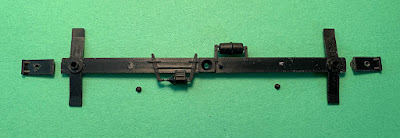This is a continuation of my project to model one of Southern Pacific’s tank cars with circumferential rivet rows joining the tank segments. The last class of such SP cars to be built was Class O-50-9, which I am modeling. I began with an Athearn tank car, dimensionally correct for the SP car, following the steps shown some time ago in a post about the corrections needed to the Athearn car (see that description at: https://modelingthesp.blogspot.com/2011/05/modeling-sp-tank-cars.html ).
With the new rivet rows placed using Archer Rivets, the body was approaching completion (more about that process was in my Part 3: https://modelingthesp.blogspot.com/2020/09/modeling-sp-o-50-9-car-part-3.html ). In the repeated photo below, you can see the double safety valve (Owl Mountain Models) in an “elbow” mount on the right side of the raised dome and the new rivet rows (the dark ones; the light ones are remnants of the superfluous ones molded on the Athearn body, which were removed).
In that previous post, I had fabricated the first segment of the new handrail (visible above), but had not yet completed it. I have shown the process of making such a handrail in several places, most recently with a diesel-fuel tank car (here’s a repeat of that link: https://modelingthesp.blogspot.com/2023/06/sp-diesel-fuel-tank-car-conclusion.html ). As the car will be painted black, thus making the clunky Athearn handrail supports considerably less obvious, I decided to leave them in place.
Joining two pieces of handrail, of course, requires some sort of connector. One way to do this, originally described by Ted Culotta in one of his modeling articles, is to use a short length of hypodermic tubing. For the 0.020-inch K&S brass wire being used on this model, you can use 0.020-inch inside diameter hypodermic tubing (available from Small Parts at www.smallparts.com – the smallest quantity is 12-inch lengths, definitely a lifetime supply). It’s shown below, to the right of the two tank bands.
The handrail was secured to the support posts with canopy glue, as was the joint (above) between wire segments that was covered by hypodermic tubing.
Meanwhile, the Athearn underframe needs certain modifications. I have not usually shown these in past posts, so will show specifics here. I begin with the “cover plate” part, that attaches to the main underframe. I attach this part as Athearn intended, then drill out the coupler box posts from what will be the top, and tap 2-56. I then cut off the box lids behind the rivet row on them. This provides a removable and dependable coupler box arrangement.
Note below I have also shaved off the extraneous extra bottom outlets on the cover plate, molded here to suit Athearn’s three-compartment tank car. The same is done on the top of the other underframe part.
The next step is to add some brake rodding to the levers that Athearn has provided. This helps with the visibility of the brake rigging from above, when the car is complete. Coupler box covers are attached. Piping to the AB valve remains to be added.
Turning the underframe over, I insert the Athearn-supplied brake stand and when glue has set, cut it off flush with the walkway (an easy way to plug Athearn’s rectangular hole). I then drill a hole for a wire brake staff, with brass brake wheel soldered to it (I make batches of these so I always have a few on hand). I also insert Athearn’s metal placard holders. They are oversize, but quite sturdy, and in any event, the placards I apply are correct size, so will look all right on a black holder.
The completed but as yet unpainted underframe is shown below. The wires simulating piping to the valve are visible, as is the new vertical-staff hand brake. The scars where the pipes for outlets of the outer compartments of the three-compartment tank car were removed are evident too.
This car class, numbering 200 cars, was built by General American at Warren Ohio, during September–December 1924. A word about the equipment assigned to these cars: they were built with T-section trucks, popular with SP during the 1920s, and with K brakes, standard for the era.
However, I know from the SP Car Ledgers (for more about them, see: https://modelingthesp.blogspot.com/2021/10/sp-car-ledger-donation-part-2.html ) that nearly all the O-50-9 cars had their T-section trucks replaced with U-section trucks during 1946–1953. In the same period, most cars had their K brakes replaced with AB brakes. I model 1953, so my model has AB brakes and U-section trucks (as the Athearn model provides).
Now the car body and underframe will be painted black, preparatory to lettering. I will use the Tichy #10053 decal set for these cars. But all that will be presented in a future post.
Tony Thompson





No comments:
Post a Comment